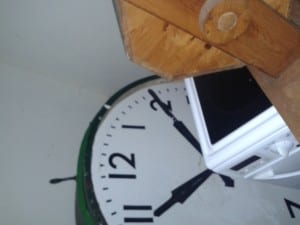As our piece has moved over hurdles over the past few weeks we as a group have been looking forward to the finish line for our final product. In order to created our journey from the start to the end, we first looked at the space’s connotations and how we would apply them to our process.
Once a resting place for the homeless, the Grandstand a fellow outsider of Lincoln society stands on the out skirts of the city looking in. From the glory of temporarily housing the once lucky to the unlucky. The potentially rich to now the penniless; We discovered an overall theme of loss permeates this building. Similar to site specific choreographer Willi Dorner we too looked into the past and future of our site. We also found similarities between his findings from his Snienton Market project in Nottingham in 2005 and ours from The Grandstand. ” I got to see a place which seemed to me empty, silent and uncared for… I had a feeling that the perspective of tomorrow seemed vague and empty” ((Dance4 Toolkit 2005)) As we were shown around inside of the Grandstand on our second week we came to realize that the future of this space is a question mark. Likewise to the market, the insides of the Grandstand are empty and in terms of the weighing room (our main performance space) it also seems uncared for. Taking this into consideration along with the theme of loss, we explored further into the spaces past purpose as a racecourse center and felt it necessary to continue looking into its journey from being a positive to a negative space. So in order to capture some of its old life we felt we needed to critically address what our performance could include with inspiration from Mike Pearson’s Why Performance study notes this helped us question ” What happens here, has happened here, might happen here” (( Pearson, Mike,2011,Why Performance,http://www.landscape.ac.uk/landscape/documents/eventpapers/toolkit/1whyperformance.pdf,Accessed 12/03/2013 )). When drawing upon”what happened here” we were intrigued by the loss caused by the gambling and betting that would of taken place, and how that experience can turn from being a positive to a negative experience.
We even placed a bet ourselves at a local betting shop in the opening race for the Cheltenham festival to get a first hand experience of the emotions that go through a person when gambling. From a personal perspective, i was a little unsure about placing a bet due to my beliefs. As a Christian i am taught that seeking wealth and love of money is not the root to true happiness. Even though gambling is not directly mentioned in the Bible, it does mention that a love of money can be a curse and cause all kinds of downfall: Ecclesiastes 5vs 10-17 ((The Holy Bible, New Century version,2003:Thomas Nelson Inc))
” 10 Who ever loves money
Will never have enough money
Whoever loves wealth will not be satisfied with it “
“13 I have seen real misery here on earth:
money saved is a curse to its owners.
14 They loose it all in a bad deal
and have nothing to give their children.
15 People come into this world with nothing,
and when they die they leave with nothing.
16 -So what do they get from chasing the wind?
17 All they get are days full of sadness and sorrow,
and they end up sick, defeated and angry.”
Here i have highlighted the words in this passage which i find most significant to my personal thoughts on what loss is and also its links towards gambling and the emotions it can cause. When betting on a horse to discover it lost, it did result in some emotion of defeat although i was not in complete distress because i lost, i did it for the experience but i was reminded a real gamblers aim is to win. When i was in the shop i observed that the majority of spectators were men. It posed the questions of : Are some of these men fathers? Back in the days of the Grandstand the likelihood of spectators being fathers was most likely, as it is a place of heritage. A place of memories for some families and Grandparents. Another was; Have their trips to the betting shop been made apparent to their children? What is the probability that this is how they increase their money to provide that bit extra for their family; in hope they do not loose it completely ? This relates back to verse 14 They loose it all in a bad deal. This could be the definition of all kinds of gambling. When the Bible talks about children here, it can also show loss through a generational context rather than just in the present. It gives an insight into how gambling and loss can have a butterfly effect in the future. Here is were this passage links loss with the Grandstand. in depicting how loss can have a chain reaction with its past and future.
So to make this journey slightly personal i decided i wanted to include some of this scripture in the piece, however due to timing issues instead of having a line each from the chapter, we collectively chose verse 15 as we all felt it conveyed a harsh but true reality. The mention of the word nothing we felt related very contingently with the last line of the poem which we recite at the beginning of the piece. ” The Horse gets nothing“. (( Bastasa,s,Ric ,2010” the horse that i am riding”,http://www.poemhunter.com/poem/the-horse-that-i-am-riding/, Accessed 12/03/2013)) Furthermore showing loss can affect all things regardless of what race your in.
